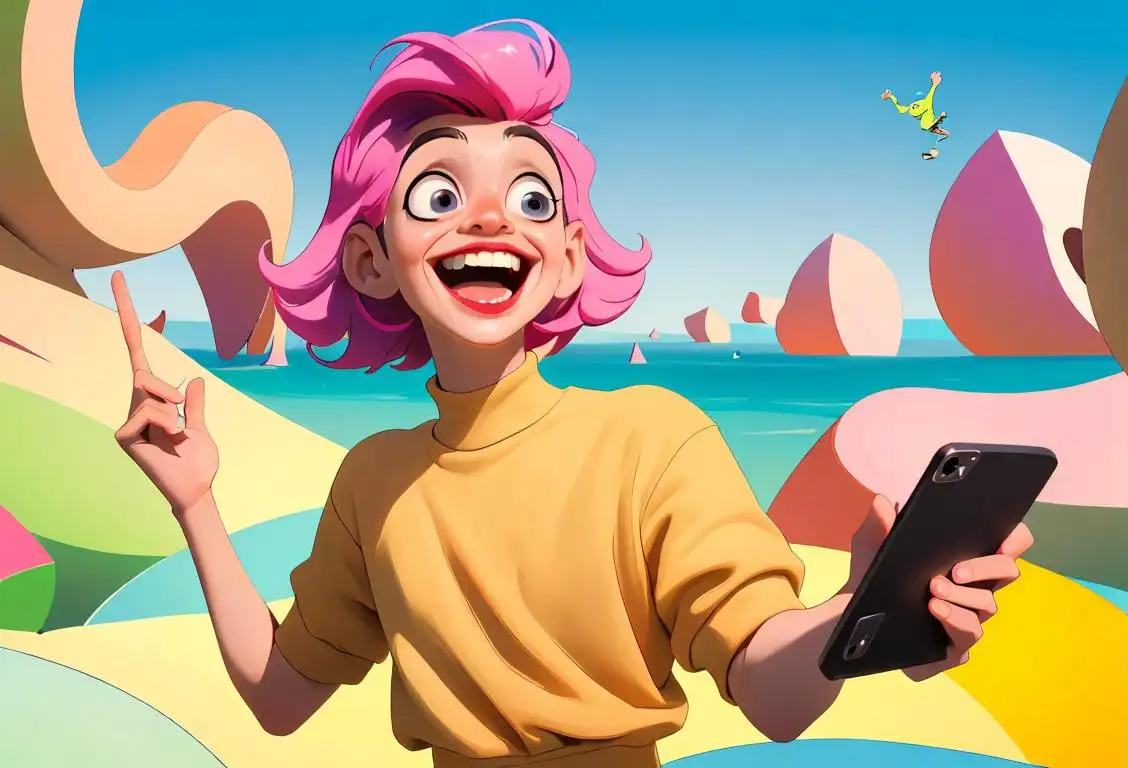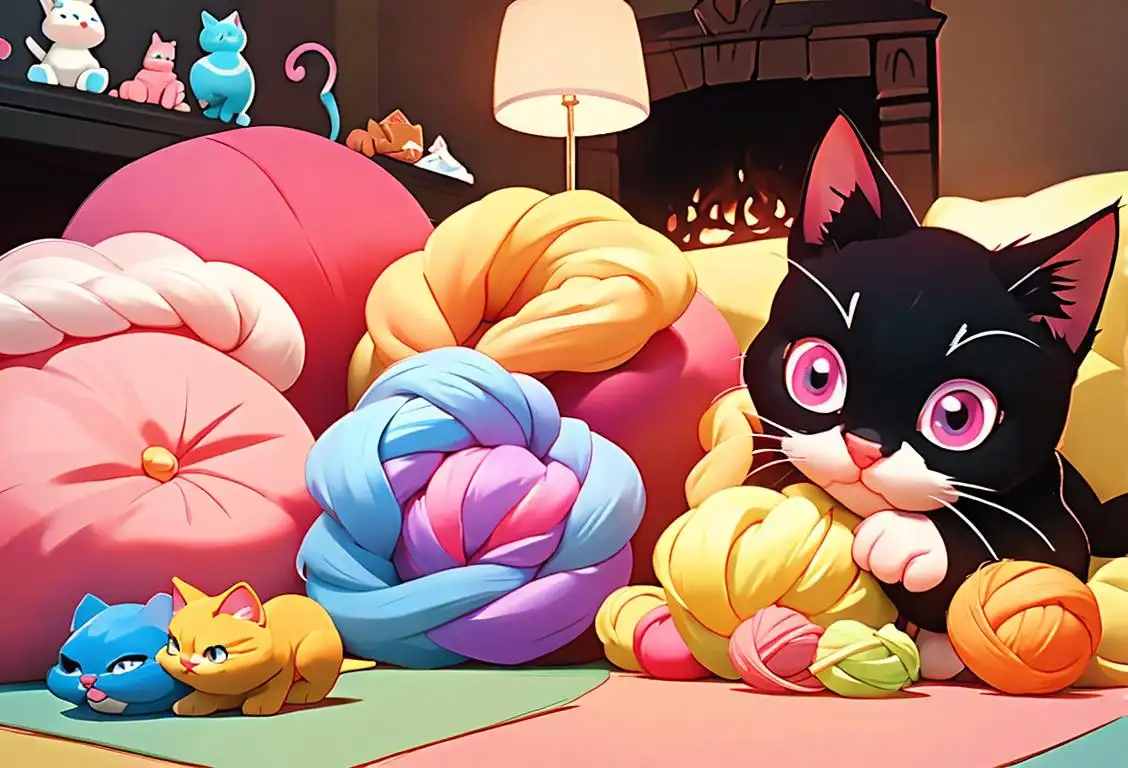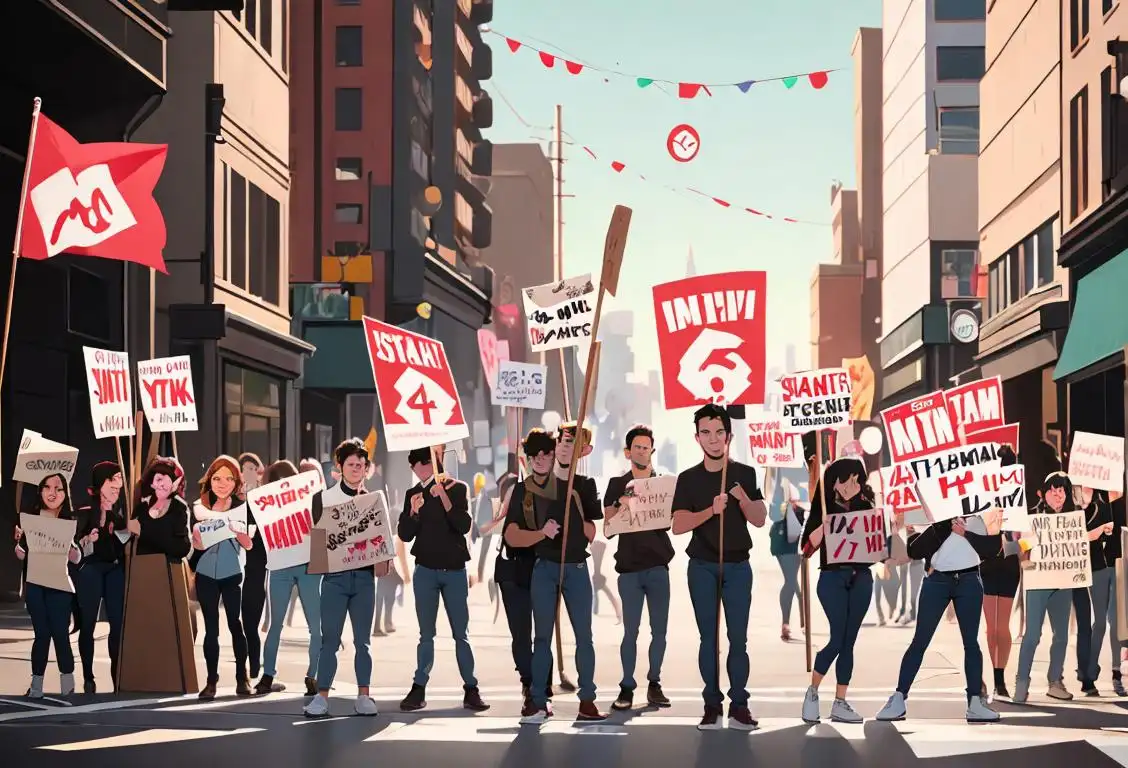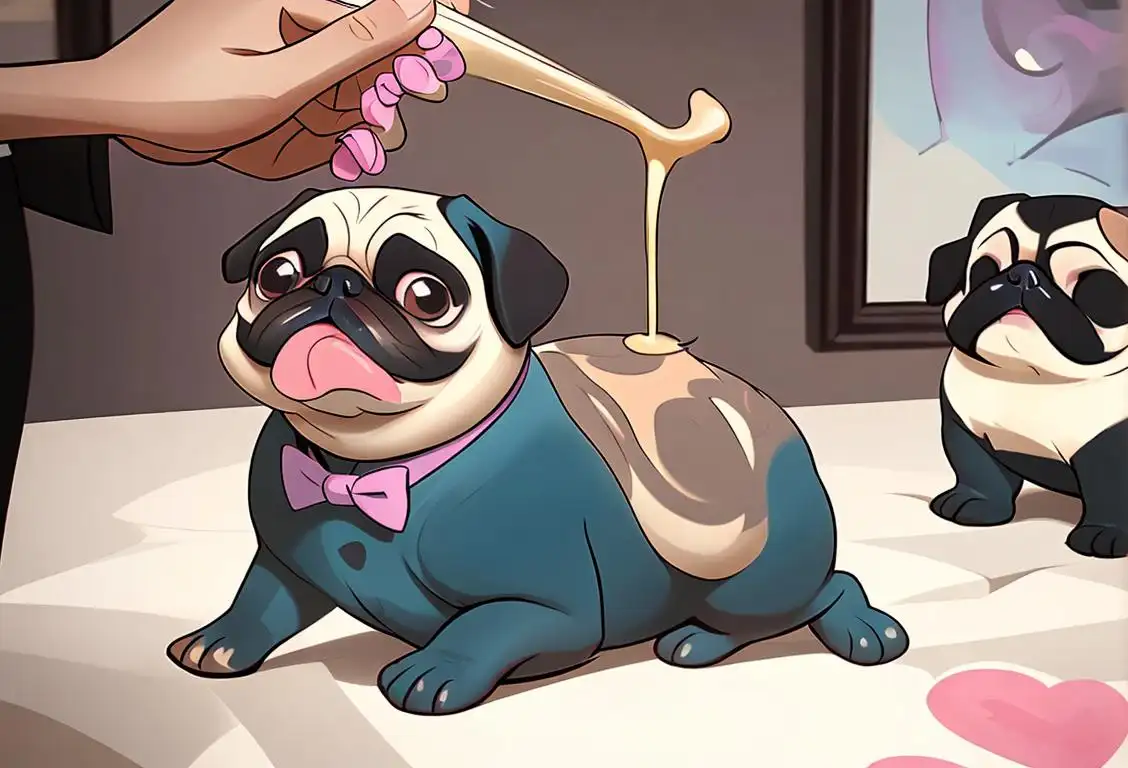National Meme Day

Well hello there, fellow internet dweller! Today, we're pressing pause on the cat videos and funny fails to celebrate a form of digital expression that has induced both laughter and facepalms the world over - memes. That's right, National Meme Day is an uncontrollable laugh you weren't expecting!
When is Meme Day?
It's national meme day on the 15th November.
A Day for the Dank and the Wholesome
Believe it or not, National Meme Day is a thing, and is celebrated with all the gusto it deserves. Some of you might go, 'Seriously? There's a day for that?', and we would say - 'you bet your bottom dollar there is!'. We detected 220 mentions of this extraordinary day online, with the most mentions occurring on November 15, 2017. This special day is a chance for all of us to tip our virtual hats to the unorthodox humor and clever commentary seen in our daily memes.
Funky Origins
Truth be told, we couldn’t track down the exact beginnings of National Meme Day. It might have been started by a giggling group of internet trolls or perhaps by a socially conscious citizen who understood the power of memes in modern discourse. Regardless of the origins, the day provides an official reason (as if we needed one) to share our favorite memes and fill our feeds with the very best of internet culture.
Spreading the Meme Magic
So, this National Meme Day click on those dank memes that you-shouldn't-be-watching-at-work, share a wholesome one with your granny, or confuse your parents by explaining what a keyboard cat is. Get out there and celebrate the digital pieces of art that make our days a bit more bearable and our smiles a bit wider.
History behind the term 'Meme'
1976
The Birth of the Term
The term 'meme' was coined by Richard Dawkins, a British ethologist and evolutionary biologist, in his book 'The Selfish Gene' published in 1976. Dawkins used the term to refer to an idea, behavior, or style that spreads from person to person within a culture. He likened memes to genes, suggesting that they reproduce and evolve through human communication, just like genetic information does through reproduction.
1976
Richard Dawkins coins the term 'meme'
In 1976, evolutionary biologist Richard Dawkins introduced the term 'meme' in his book 'The Selfish Gene.' Dawkins used the term to refer to a cultural idea or behavior that spreads from person to person within a society. He drew a parallel between memes and genes, suggesting that just as genes are units of biological information, memes are units of cultural information.
1976
Coined by Richard Dawkins
The term 'meme' was first coined by Richard Dawkins in his book 'The Selfish Gene' published in 1976. Dawkins defined a meme as a unit of cultural transmission, an idea, behavior, or style that spreads from person to person within a culture.
1976
Richard Dawkins coins the term 'meme'
In 1976, renowned evolutionary biologist Richard Dawkins first introduced the term 'meme' in his book 'The Selfish Gene.' He coined it as a concept to explain how ideas and cultural phenomena spread and evolve in a manner similar to genes in biological evolution. Dawkins derived the term 'meme' from the Greek word 'mimeme,' meaning 'that which is imitated.' With this invention, Dawkins laid the foundation for the study of memes in the field of cultural evolution.
1976
Origins of the term 'meme'
The term 'meme' was first coined by Richard Dawkins, a British evolutionary biologist, in his book titled 'The Selfish Gene' published in 1976. Dawkins used the word 'meme' to describe an idea or cultural symbol that spreads and replicates in a manner similar to genes in biological evolution. He derived the term from the Greek word 'mimeme', which means 'imitated thing'. Dawkins proposed that memes could evolve through the process of cultural transmission, where successful memes are copied and passed on to others.
1976
Richard Dawkins coins the term 'meme'
In 1976, British evolutionary biologist, Richard Dawkins, introduced the term 'meme' in his book 'The Selfish Gene'. He defined a meme as an idea, behavior, or cultural symbol that spreads from person to person within a culture. Dawkins compared memes to genes, suggesting that they undergo a form of natural selection and evolve over time.
1976
The Term is Coined
The term 'meme' was coined by Richard Dawkins, an evolutionary biologist, in his book 'The Selfish Gene' published in 1976. Dawkins used the term to describe an idea, behavior, or style that spreads from person to person within a culture. He likened memes to genes, suggesting that they replicate and spread, often evolving and adapting over time.
1976
The Birth of the Term
The term 'meme' was first coined by Richard Dawkins, the British evolutionary biologist, in his 1976 book 'The Selfish Gene'. Dawkins used the term to describe how cultural information spreads and evolves in a way similar to genes in biology. He defined a meme as an idea, behavior, or style that spreads from person to person within a culture.
1976
Richard Dawkins introduces the term 'meme'
In the year 1976, the renowned evolutionary biologist Richard Dawkins introduced the term 'meme' in his book 'The Selfish Gene'. Dawkins coined this term to describe cultural ideas, behaviors, or styles that spread from person to person within a society, much like genes spread within a population. He compared memes to infectious viruses, highlighting their ability to replicate and evolve through imitation.
1993
The Internet's Influence
In 1993, the concept of memes began to transcend its original meaning when Mike Godwin, an American attorney, introduced the term 'Internet meme' to describe images, videos, or captions that circulated rapidly across various online communities. This new definition encompassed humorous or viral content that became popular and widely shared on the emerging internet, often capturing the essence of internet culture and internet humor.
1993
Evolution of the Internet
With the exponential growth of the internet in the early 1990s, the concept of memes started to gain prominence. As people began sharing humorous images, videos, and ideas through email and early online forums, the term 'meme' started to be used to describe these viral content pieces.
1990
Popularization on the Internet
With the rise of the internet, the concept of memes started to gain traction in online communities. In 1990, a computer scientist named Mike Godwin created the term 'internet meme' to describe an idea or concept that spreads rapidly online. This term referred specifically to humorous or viral content shared and adapted by internet users.
1990
Introduction of internet memes
The concept of memes gained popularity in the early 1990s with the rise of the internet and online communities. Initially, internet memes referred to humorous images or text that spread rapidly across forums and message boards. One of the earliest examples of an internet meme is the animated GIF of a dancing baby known as 'Baby Cha-Cha', which circulated widely in 1996. As the internet became more accessible, memes started to encompass a wide range of content, including jokes, catchphrases, and viral videos.
1996
Internet culture embraces memes
By the mid-1990s, memes had gained popularity on the internet. Internet users began sharing humorous and viral content, including images, videos, and catchphrases. Memes became a way for people to express humor, commentary, and emotions in a visual format. One of the earliest and most well-known internet memes is the 'Dancing Baby', which gained widespread attention in 1996.
1993
The term 'meme' gains popularity on the internet
By the early 1990s, as the internet started to gain mainstream popularity, the term 'meme' found its way into online communities. One of the earliest instances of internet memes was the ASCII art meme featuring the 'Dancing Baby,' which circulated via email and message boards. The emergence of the internet and social media platforms allowed memes to spread rapidly and reach a wider audience.
1990
Meme goes digital with the internet
The internet revolution in the 1990s played a significant role in popularizing the concept of memes. As internet usage grew, people began sharing and spreading various humorous and viral content, often in the form of images, captions, or short videos. Memes resonated deeply with internet culture, providing a platform for people worldwide to connect and participate in the creation and dissemination of ideas. This digital medium allowed memes to evolve and spread rapidly, leading to an explosion of internet memes in the following decades.
1996
Internet Memes Emerge
The term 'meme' gained popularity on the internet in the mid-1990s. Internet memes first appeared on online platforms like Usenet and early internet forums, where users would create and share humorous content, images, or videos that went viral. This emergence marked a shift from the traditional understanding of memes as cultural ideas to internet-specific cultural phenomena.
1990
Internet emerges as a platform for meme spread
By the early 1990s, the internet became widely accessible to the public, providing a new platform for the rapid dissemination of memes. Online communities, such as Usenet and bulletin board systems, played a significant role in the early propagation of internet memes. Memes, typically in the form of humorous images, catchphrases, or jokes, began to circulate widely through email chains and discussion forums.
2005
The rise of image macros and meme generators
In 2005, the concept of image macros took the meme world by storm. Image macros are images combined with captions to create humorous or relatable content. Websites like 4chan and Reddit became popular platforms for creating and sharing these image-based memes. Meme generators were also introduced, allowing users to easily create their own memes using pre-existing templates.
2005
Memes go viral on image-sharing websites
Image-sharing websites like 4chan, Reddit, and later, 9GAG, played a significant role in popularizing memes during the mid-2000s. Users began creating and sharing image-based memes with captions, often humorous or relatable, which quickly spread across the internet. Memes such as 'LOLcats' (featuring funny cat pictures) and 'Rage Comics' gained immense popularity and showcased the creative potential of the meme format.
2005
The emergence of image macros
Image macros became a popular form of meme in the mid-2000s. An image macro consists of a humorous or relatable image combined with overlaid text, often written in a specific style such as Impact font. This format allowed internet users to create their own memes by adding captions to existing images, enabling widespread remixing and adaptation. Memes such as 'I Can Has Cheezburger?' and 'LOLcats' became highly popular during this time, showcasing the power of image macros in creating shareable and relatable content.
2005
The birth of 'LOLcats'
In 2005, the internet witnessed the emergence of a meme subculture known as 'LOLcats.' Characterized by images of cats with humorous captions, often written in a distinct style with intentional grammar and spelling errors, LOLcats became wildly popular. This phenomenon proved that memes could go beyond simple jokes and evolve their own unique language and aesthetics. The humor and relatability of LOLcats resonated with millions of internet users, further solidifying the meme's place in popular culture.
1996
Birth of 'Dancing Baby'
In 1996, a 3D-rendered animated baby dancing to the song 'Hooked on a Feeling' went viral. Known as the 'Dancing Baby' or 'Baby Cha-Cha,' it became one of the first internet memes to achieve widespread popularity, sparking the public's fascination with online viral content.
2000
The birth of image macros and early viral memes
In the early 2000s, the rise of image macro memes became a significant phenomenon on the internet. Image macros are images overlaid with bold captions in distinctive fonts, often conveying humor or satire. Memes like 'All Your Base Are Belong To Us' and 'I Can Has Cheezburger?' gained immense popularity, spreading rapidly across blogs, forums, and social media platforms like Myspace and early versions of Facebook.
2005
Dawkins Acknowledges Internet Memes
In 2005, Richard Dawkins acknowledged the impact of internet memes and the new definition it had taken on. He expressed his approval of the viral internet content that was being referred to as 'memes,' stating that it was a good example of the original concept he had introduced in his book.
2005
The Rise of Image Memes
Around 2005, internet memes took a significant turn with the emergence of image-based memes. Websites like 4chan, Reddit, and later, the meme-focused platform, 9GAG, became hubs for sharing and remixing image macros, which are images overlaid with amusing captions. Memes such as 'LOLcats,' 'Rickrolling,' and the 'Advice Animal' series gained immense popularity and played a pivotal role in solidifying the visual language and format of modern internet memes.
2005
The Rise of LOLCats
In 2005, a significant internet meme known as 'LOLCats' took hold. 'LOL' stands for 'laugh out loud,' and the meme involved captioning pictures of cats with intentionally misspelled and grammatically incorrect phrases. This meme gained immense popularity and paved the way for other image-based internet memes.
2010
The rise of viral internet memes
With the growth of social media platforms like Facebook, Twitter, and Instagram, the dissemination of memes reached new heights. Memes started to spread rapidly, reaching a global audience and becoming ingrained in popular culture. Memes such as 'Distracted Boyfriend', 'Harlem Shake', and 'Grumpy Cat' gained immense popularity during this period, attracting millions of views and shares. The ability of memes to convey humor, commentary, and relatability in a concise and shareable format contributed to their viral nature and cultural impact.
2012
Gangnam Style takes the meme world by storm
In 2012, South Korean artist Psy released a music video called 'Gangnam Style,' which quickly went viral. This song and its accompanying dance moves became a global sensation, captivating audiences worldwide. 'Gangnam Style' not only showcased the power of memes to spread across different cultures and languages but also highlighted the global reach and influence of internet memes. The video's immense popularity led to countless parodies, remixes, and references, solidifying its place in meme history.
2013
Memes as a Global Phenomenon
By 2013, memes had become a global phenomenon, spreading rapidly across various social media platforms. The popularity and accessibility of platforms such as Twitter, Instagram, and Reddit allowed memes to reach a wider audience and evolve at a faster pace. Memes became a way for people to express humor, share cultural references, and comment on current events.
2012
The rise of internet meme culture
In 2012, internet meme culture reached new heights, with memes becoming a cultural phenomenon. Platforms like Tumblr, Instagram, and Twitter became breeding grounds for the creation and sharing of memes. Memes began to permeate various aspects of popular culture, influencing advertising, politics, and entertainment. Memes allowed people to express themselves in a relatable and shareable way, creating a sense of collective humor and understanding.
2007
Rickrolling Takes Over
In 2007, the internet was 'rickrolled' as a meme phenomenon. 'Rickrolling' refers to the practice of tricking someone into clicking a hyperlink that leads to the music video for Rick Astley's song 'Never Gonna Give You Up.' This unexpected and widespread trend became a cultural sensation, highlighting the power of internet memes to create shared experiences and generate humor.
2006
The emergence of internet meme culture and platforms
In the year 2006, internet meme culture experienced a significant boost with the launch of dedicated platforms such as 4chan, Reddit, and later, Tumblr. These platforms fostered a communal atmosphere where users could create, remix, and share memes with a global audience. The rapid growth of these platforms led to the viral spread of countless memes, allowing internet subcultures and trends to flourish.
2005
Rise of Image Macros
Image macros, an early form of memes, became increasingly popular with the launch of websites like 4chan and Reddit. People started overlaying humorous captions onto pictures, creating a new form of visual memes. Memes such as 'I Can Has Cheezburger?' and 'Success Kid' gained widespread recognition during this time.
2010
Mainstream Recognition
By 2010, internet memes had infiltrated mainstream culture. Memes were no longer confined to online communities; they became a significant part of everyday communication. YouTube sensations like 'Charlie Bit My Finger' and viral photos like 'Success Kid' became widely recognized and shared across social media platforms. Brands, politicians, and celebrities also began incorporating memes into their marketing strategies, further propelling meme culture into the mainstream consciousness.
2013
The 'Harlem Shake' meme goes viral
In 2013, the 'Harlem Shake' meme took the internet by storm. It involved short videos featuring people dancing to the song 'Harlem Shake' by Baauer. The meme spread like wildfire, with numerous variations and parodies being created within a short period. The 'Harlem Shake' meme showcased the power of virality and how memes could quickly capture the attention of millions of internet users.
2010
The 'Trollface' Phenomenon
One of the most influential memes of the early 2010s was the 'Trollface.' Initially created in 2008, this crudely drawn smirking face gained widespread popularity as an image used to troll or mock others online. The 'Trollface' became emblematic of internet culture at the time.
Present
Enduring influence and evolution of memes
Memes have become an integral part of internet culture, continuing to evolve and adapt with changing trends and platforms. They have expanded beyond image macros to include video memes, reaction GIFs, TikTok challenges, and more. Memes serve as a form of cultural expression, social commentary, and entertainment, reflecting the shared experiences and humor of online communities. The ubiquitous nature of memes has led to their incorporation in advertising, politics, and even academic research. As internet culture continues to evolve, memes are likely to remain a prominent and ever-evolving medium of communication.
2021
Memes become a language of the internet
Today, memes have become an integral part of internet communication. With the advent of platforms like TikTok and meme-focused subreddits, memes continue to evolve and adapt to changing internet trends. Memes have shaped online discourse, reflecting societal attitudes, challenging norms, and bridging cultural gaps. Memes provide a shared language for internet users worldwide, allowing for the rapid spread and exchange of ideas.
2021
Memes Shape Pop Culture
In the present day, memes have firmly established themselves as a significant aspect of internet culture and have even influenced mainstream pop culture. Memes have been used in advertising campaigns, political discourse, and have impacted various forms of media. They have become a creative and powerful tool for communication, enabling people from different corners of the world to connect and share ideas through humor and shared experiences.
2020
COVID-19 brings memes as a coping mechanism
The COVID-19 pandemic in 2020 ushered in a new era of memes as a form of collective coping and humor. In a time of uncertainty and isolation, internet users turned to memes as a means to navigate the challenges and find moments of levity. Memes related to quarantine, social distancing, and other pandemic-related topics became widespread, providing people with a shared language and a way to connect during a time of global crisis. The resilience and adaptability of memes demonstrated their ability to reflect and respond to current events, serving as a testament to the cultural impact of this phenomenon.
2012
The rise of social media and mainstream memeification
The year 2012 marked a turning point in the meme landscape with the increased influence of social media platforms like Facebook, Twitter, and Instagram. Memes became more mainstream, transcending internet subcultures and making their way into everyday conversations. Memes like 'Grumpy Cat', 'Gangnam Style', and the 'Harlem Shake' went viral, reaching millions of people globally within a short span of time.
2018
Memes become a mainstream cultural phenomenon
Memes have become an integral part of modern internet culture and have transcended the online world. In 2018, memes started to gain mainstream attention and recognition. Memes were being referenced in advertising campaigns, incorporated into news stories, and even featured in art exhibitions. Popular memes, such as 'Distracted Boyfriend' and 'Doge', became widely recognizable and entered into popular discourse. Memes had transformed from fleeting internet trends to influential cultural touchstones.
Present
An Ever-Evolving Phenomenon
Today, internet memes continue to evolve at an unprecedented pace. Platforms like TikTok, Instagram, and Twitter have become hotbeds for meme creation and dissemination. Memes not only provide entertainment but also serve as vehicles for social commentary and cultural expression, reflecting the collective experience of diverse communities. They have become a language of their own, shaping and influencing popular culture in a way that was unimaginable when Richard Dawkins first introduced the concept of memes in 1976.
2012
The Harlem Shake Goes Viral
One of the most popular video-based memes, the 'Harlem Shake,' gained popularity in 2012. The meme involved a short video with an initial calm scene that abruptly transitioned to a lively dance by a group of people. People across the world started creating their own versions, leading to millions of videos being shared on various platforms.
2021
Memes as cultural symbols and modes of expression
Today, memes have evolved into a powerful form of cultural expression, reflecting contemporary social and political issues. They serve as a vehicle for humor, commentary, and social critique. Memes have also become an integral part of advertising, with brands harnessing their virality to engage with audiences. The ubiquity of memes demonstrates their cultural impact, serving as a testament to the ever-evolving nature of online communication and collective creativity.
2020
Memes as a Form of Communication
In recent years, memes have become a prominent form of communication and cultural expression. Memes are used to convey complex ideas, social commentary, and humor in a concise and relatable manner. They have infiltrated social media platforms, news outlets, and everyday conversations, making them an essential part of contemporary internet and popular culture.
2013
Vine and Virality
The launch of the short-form video app, Vine, in 2013 revolutionized the meme landscape. Users created and shared six-second looping videos, leading to the rise of viral catchphrases and characters like the 'Damn Daniel' video. Vine paved the way for memes to find a home in video format.
2018
Memes in Mainstream Culture
By 2018, memes had firmly embedded themselves into mainstream culture. Examples like 'Distracted Boyfriend' and 'Harambe' became global sensations, being shared and referenced beyond internet communities. Memes were no longer limited to the internet; they had become a cultural phenomenon.
Did you know?
Did you know that the term 'meme' was first introduced by biologist Richard Dawkins in his 1976 book 'The Selfish Gene'? He defined it as an idea, behavior or style that spreads from person to person within a culture.Tagged
awareness fun internet culture memes digital expressionFirst identified
15th April 2015Most mentioned on
15th November 2017Total mentions
220Other days
Meme Day
Catra Day
Work Naked Day
Eat Ya Girls Ass Day
Pabebe Wave Pabuko Day
Lumpy Rug Day
Fckboy Day
Talk Like A Pirate Day
Strike Day
Pug Day






